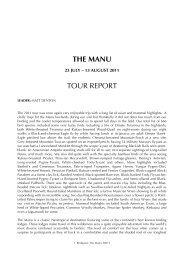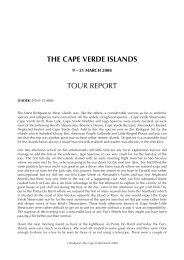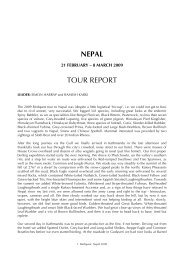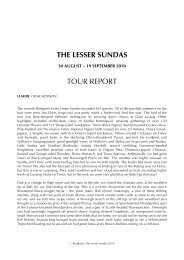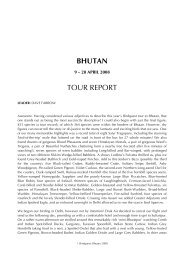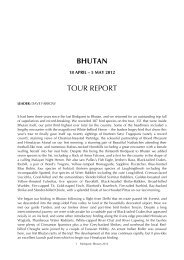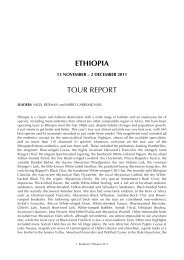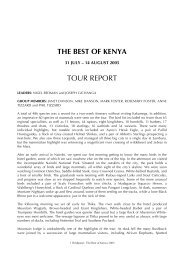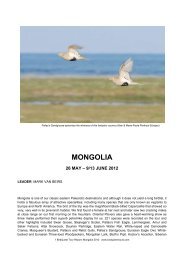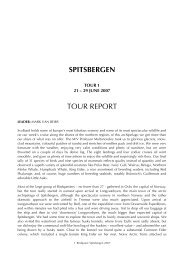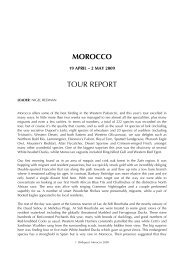Download Full Tour Report 3262kb - Birdquest
Download Full Tour Report 3262kb - Birdquest
Download Full Tour Report 3262kb - Birdquest
Create successful ePaper yourself
Turn your PDF publications into a flip-book with our unique Google optimized e-Paper software.
Striated Heron Butorides striata: The most common heron throughout our area. Note that birds from<br />
North America have been split and now referred to as the Green Heron.<br />
Western Cattle Egret Bubulcus ibis: Common and widespread in open areas. The nominate race of<br />
this species apparently invaded South America in the late 19th century, one of the most<br />
rapid avian range expansions in historic times.<br />
Cocoi Heron (White-necked H) Ardea cocoi: A few birds encountered along the Rio Solimões, one<br />
in the Anavilhanas and a few in Roraima.<br />
Great Egret Casmerodius albus: Large numbers along the Rio Solimões and other sites with aquatic<br />
environments. Note that at present this species is sometimes placed within the genus<br />
Ardea.<br />
Capped Heron Pilherodius pileatus: Up to seven seen along the Igarape Januari and a few in<br />
Roraima.<br />
Snowy Egret Egretta thula: Very common on Marchantaria and along the Careiro road.<br />
THRESKIORNITHIDAE<br />
Green Ibis Mesembrinibis cayennensis: One seen in at Janauari and another in Mindu Park.<br />
Buff-necked Ibis Theristicus infuscatus : One seen along the Careiro road was an extralimital record.<br />
Common in the savannas of Roraima.<br />
CICONIDAE<br />
Wood Stork Mycteria mycteria: A few in Roraima.<br />
Maguari Stork Ciconia maguari: Up to 30 in Roraima.<br />
Jabiru Jabiru mycteria: Up to 20 in Roraima.<br />
CATHARTIDAE<br />
Turkey Vulture Cathartes aura: Common throughout the trip in open and urban areas. Although<br />
traditionally placed with raptors modern studies indicate a more convoluted origin<br />
placing them nearer storks. No doubt the ongoing taxonomic research will again revise<br />
this.<br />
Lesser Yellow-headed Vulture Cathartes burrovianus: Numerous on Marchantaria and along the<br />
Solimoes.<br />
Greater Yellow-headed Vulture Cathartes melambrotus: The commonest vulture of forested areas<br />
north of Manaus and around São Gabriel.<br />
Black Vulture (American B V) Coragyps atratus: Abundant throughout the tour.<br />
King Vulture Sarcoramphus papa: One seen at Iracema falls. The specific name papa is Latin for<br />
bishop and the name refers to the immaculate white plumage of the adult.<br />
ACCIPITRIDAE<br />
Osprey Pandion haliaetus : A couple seen along the Rio Negro.<br />
Grey-headed Kite Leptodon cayanensis: A single bird seen along the Rio Negro. A somewhat thinly<br />
distributed species.<br />
Swallow-tailed Kite (American S-t K) Elanoides forficatus: A big group during our second visit to the<br />
INPA Tower.<br />
Pearl Kite Gampsonyx swainsonii: Two seen in Roraima.<br />
White-tailed Kite Elanurus leucurus: A few in Roraima.<br />
Snail Kite (Everglade K) Rostrhamus sociabilis: Numerous on Marchantaria and along the Careiro<br />
Road. This species feeds almost exclusively on apple snails (Pomacea sp.), apparently<br />
without ill effect.<br />
Slender-billed Kite Rostrhamus hamatus: One seen along the Careiro road.<br />
Double-toothed Kite Harpagus bidentatus: Two birds seen at the INPA Tower and another pair along<br />
the Cucui road.<br />
Plumbeous Kite Ictinia plumbea: Several birds seen north of Manaus and other on Marchantaria.<br />
10 <strong>Birdquest</strong>: Amazonian Brazil 2011




